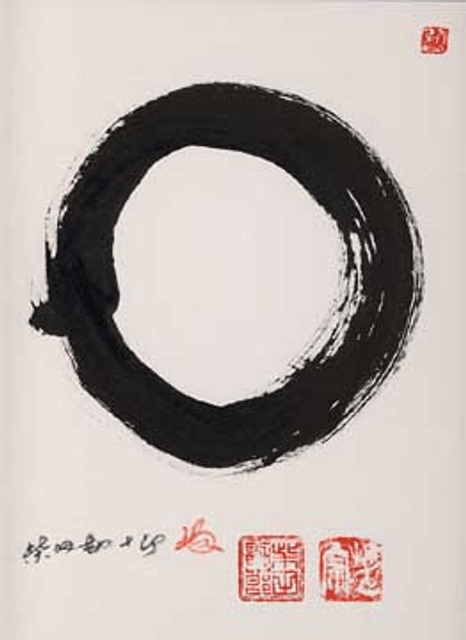Ensō

Ensō

In Zen, ensō (円相, , "circle") is a circle that is hand-drawn in one or two uninhibited brushstrokes to express a moment when the mind is free to let the body create.
Description
The ensō symbolizes absolute enlightenment, strength, elegance, the universe, and mu (the void). It is characterised by a minimalism born of Japanese aesthetics.
Drawing ensō is a disciplined-creative practice of Japanese ink painting—sumi-e (墨絵, "ink painting"). The tools and mechanics of drawing the ensō are the same as those used in traditional Japanese calligraphy: One uses a brush (筆, fude) to apply ink to washi (a thin Japanese paper).
The circle may be open or closed. In the former case, the circle is incomplete, allowing for movement and development as well as the perfection of all things. Zen practitioners relate the idea to wabi-sabi, the beauty of imperfection. When the circle is closed, it represents perfection, akin to Plato's perfect form (Plato), the reason why the circle was used for centuries in the construction of cosmological models, see Ptolemy.
Usually, a person draws the ensō in one fluid, expressive stroke. When drawn according to the sōsho (草書) style of Japanese calligraphy, the brushstroke is especially swift. Once the ensō is drawn, one does not change it. It evidences the character of its creator and the context of its creation in a brief, continuous period of time. Drawing ensō is a spiritual practice that one might perform as often as once per day.[1]
This spiritual practice of drawing ensō or writing Japanese calligraphy for self-realization is called hitsuzendō (筆禅道, "way of the brush"). Ensō exemplifies the various dimensions of the Japanese wabi-sabi perspective and aesthetic: Fukinsei (asymmetry, irregularity), kanso (simplicity), koko (basic; weathered), shizen (without pretense; natural), yugen (subtly profound grace), datsuzoku (freedom), and seijaku (tranquility).
Use outside of Zen Buddhism
A variation of the symbol was also used as a logo by Obaku Ltd.. They continue to use an ensō shape as a wristwatch brand.
Thinking, an international design and consulting house centred in London, uses an ensō[4] meaning "Expression" as one of their four icons, along with icons for science, pattern and vision.
Philosopher Joseph Campbell's book, The Hero with a Thousand Faces, bears this symbol on its cover representing creativity and uninhibited freedom of expression within art/literature.
The book The Lean Startup uses an enso on the cover. One of the concepts in the approach includes a learning cycle 'Build - Measure - Learn".
The design of Apple Campus 2, Apple Inc.'s ring-shaped corporate headquarters, might also have been inspired by the ensō.[5]
AMD uses an ensō in the marketing of its Ryzen processors with the Zen microarchitecture.
MINDBODY prominently features an ensō in its company logo.
HSBC bank released a card named zero [8] using as logo an ensō.
KOAN Sound uses an open ensō in their logo as the 'O' character.
The Ensō bootloader vulnerability that allows the HENkaku exploit in PlayStation Vita consoles to run permanently uses an ensō as its logo.
See also
Abstract expressionism, a 20th-century American art movement
Buddhism in Japan
Dhyāna in Buddhism, a meditation practice in which the observer detaches from several qualities of the mind
Ink wash painting, an East Asian style of brush painting that uses black ink
Ouroboros, an ancient symbol depicting a serpent or dragon eating its own tail